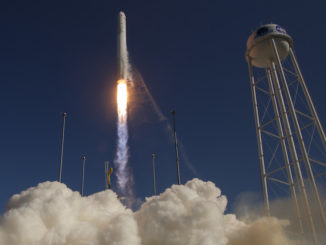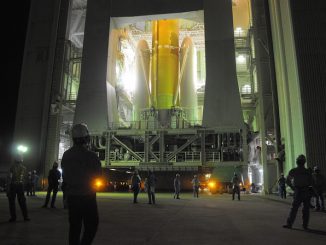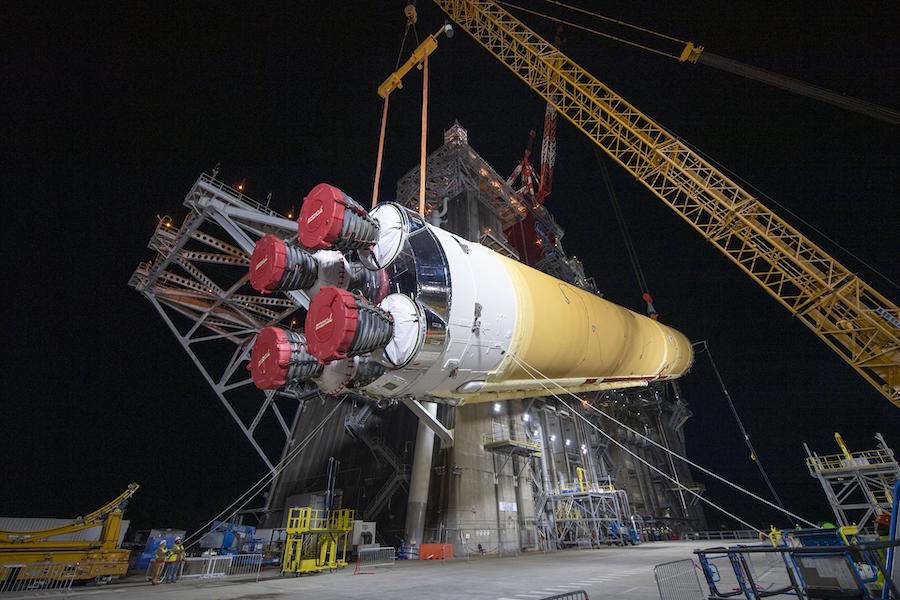
With the Space Launch System’s inaugural test flight now officially delayed to November 2021, NASA says work halted by the coronavirus pandemic will resume within weeks to prepare for the first test-firing of the SLS core stage at the Stennis Space Center in Mississippi.
The last official schedule from NASA had the first SLS test launch in March 2021, but managers have said for months that schedule was no longer achievable. After a thorough review, NASA says the first SLS launch — named Artemis 1 — is now planned in November of next year.
The most powerful launch vehicle since the Apollo-era Saturn 5 moon rocket, the Space Launch System will carry an unpiloted Orion crew capsule into space. The Orion spaceship will orbit the moon to demonstrate the capsule’s capabilities and performance before NASA commits to flying astronauts around the moon on the second SLS/Orion flight in late 2022 or early 2023.
According to NASA’s current plans, the Artemis 3 mission — scheduled as soon as 2024 — will send astronauts back to the moon on the third SLS/Orion flight. Once in lunar orbit, crew members will dock with a lunar lander and attempt a landing near the moon’s south pole.
But the development of the Space Launch System, which kicked off in 2011, has faced ballooning costs, delays and a change in strategy ordered after the Trump administration took office in 2017. Since then, the White House has directed NASA to accelerate the return of U.S. astronauts to the lunar surface to 2024.
Years behind schedule, the march toward the first SLS test launch hit another hurdle in March when NASA ordered teams at the Stennis Space Center to pause operations on the B-2 test stand, where the heavy-lift rocket’s core stage arrived in January from its factory in New Orleans.
“We basically shut down operations there March 17,” said Doug Loverro, associate administrator for NASA’s human exploration and operations mission directorate.
Originally scheduled for a debut test launch in 2017, the Space Launch System has faced repeated delays, primarily due to difficulties in building the rocket’s first flight-ready main stage, a large structure with cryogenic liquid hydrogen and liquid oxygen propellant tanks measuring 212 feet (64.6 meters) long.
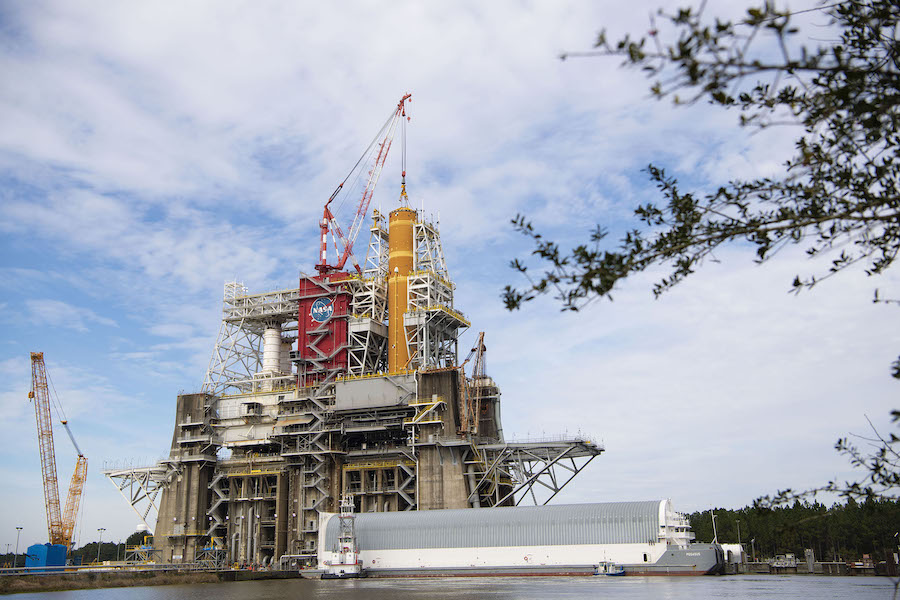
The core stage — built by Boeing — finally left its factory at NASA’s Michoud Assembly Facility in New Orleans earlier this year. In January, the stage arrived at the B-2 test stand at Stennis, the same facility once used for test-firings of the main stage of NASA’s Apollo-era Saturn 5 moon rocket.
Before the pandemic hit, NASA and contractor teams were readying for a test-firing of the SLS core stage’s four hydrogen-fueled RS-25 main engines as soon as early August. Known as the green run, the test is the culmination of the core stage’s construction and test campaign before delivery of the rocket to the Kennedy Space Center in Florida to final launch preparations.
In mid-March, rising numbers cases of the COVID-19 viral disease in the area around the Stennis Space Center — including the first confirmed positive case among the Stennis workforce — prompted NASA to stop work on the test stand. NASA also paused production of hardware for subsequent SLS launches at Michoud.
“There’s no question we’re going to lose some time to (the coronavirus pandemic), but we’ve tried to go ahead and maximize what we’ve got done,” Loverro said in an interview Wednesday. “And we’re right now working the reopening plans … For each activity that we’re doing, we are putting together a specific plan.”
In a sign that operations at Stennis are beginning to resume, Loverro said NASA has approved the painting of a different test stand used to to test-fire individual RS-25 engines that are used on the SLS core stage.
“We have three other plans in work right now that will be submitted later this week to restart work at MAF (the Michoud Assembly Facility), and restart work at Stennis in different areas,” Loverro said.
“We are going to be resuming work on the B-2 test stand in support of green run within the next couple of weeks,” Loverro said. “It won’t be at full speed, but it will be done in a safe manner so we can protect our Boeing and NASA workers down there. And we will work on the engine section, we’ll work on the thermal protection system. Each element will be started when we have the plans and the gear ready to protect those workers.”
Loverro said NASA and contractor teams continued with virtual training sessions and reviewed paperwork.
“It’s often the case in these developments that the last thing that gets done is the paperwork, so we decided that we’d get ahead on the paperwork and get a lot of it signed off. And the software development has still continued as well,” he said.
Loverro, a veteran manager in U.S. military space programs, led a comprehensive review of the SLS and Orion schedules since arriving at NASA late last year.
“We went through an entire re-baseline of the program,” he said. “We looked at every schedule, and we came to the conclusion that we had a very high confidence date of November 2021.
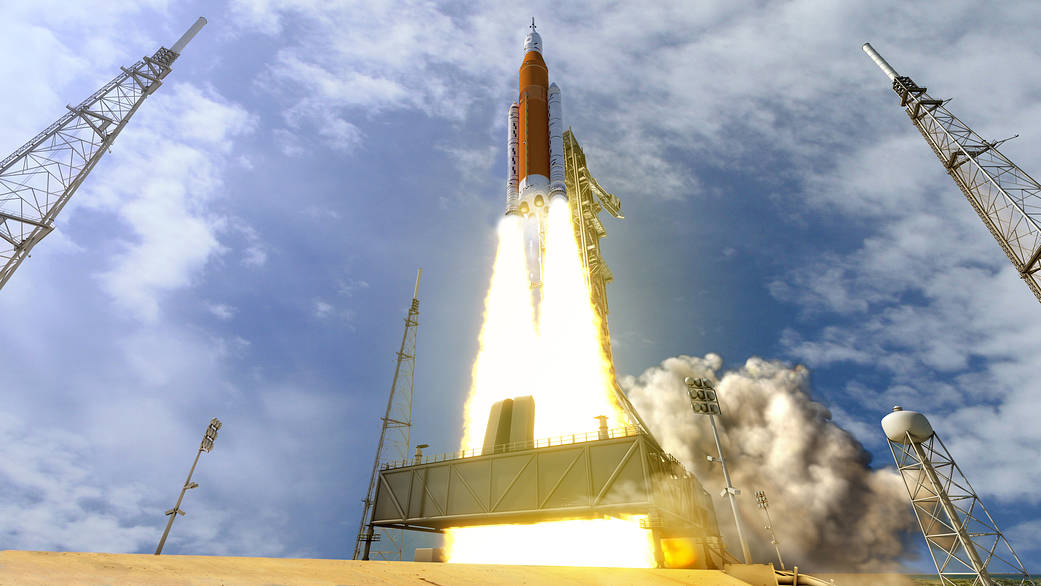
“There’s no question the COVID shutdown puts pressure on that date that we had not anticipated,” Loverro said. “I would say the work and the experience that Boeing has done so far in green run gives me great hope and confidence that they are going to get back into this and get us very near to the original schedule on this.”
He said NASA and Boeing teams at Stennis were working 10 days ahead of schedule during the green run test campaign before the shutdown in March.
“So performance was excellent,” Loverro said. “Assuming we can get back to work in the next several weeks, I think that November 2021 date is still going to hold.”
Development of the Orion spacecraft, led by Lockheed Martin and Airbus Defense and Space, has encountered its own delays. But the spaceship is on track to be ready to begin Artemis 1 launch preparations within the next few months, well ahead of the SLS timeline.
The Orion spacecraft for Artemis 1 arrived back at the Kennedy Space Center in March after thermal vacuum and electromagnetic testing at NASA’s Plum Brook Station in Ohio.
“We were able to continue with Orion using the right protective gear to make sure we took care of our people and the Lockheed people,” Loverro said. “We were able to continue with that, not as we would normally do it. But under very safe conditions, we were able to continue work there, and in fact have progressed.”
A Government Accountability Office report released this week said one of the top remaining technical risks with the Space Launch System’s core stage is that the rocket may develop leaks when filled with cryogenic liquid hydrogen and liquid oxygen for the first time.
NASA plans to load 730,000 gallons super-cold propellants into the rocket during a rehearsal for the green run test-firing. If all goes according to plan, engineers would follow the fueling test — called a wet dress rehearsal — with another propellant load culminating in a burn of all four RS-25 main engines lasting more than eight minutes.
“The next big unknown as a program is when we put the cryogenic liquids in the oxygen tank and the hydrogen tank, and we look at the plumbing and all the systems and make sure that they remain tight, and that they perform as expected through our qualification test,” said John Shannon, Boeing’s SLS program manager, in January. “We have high confidence that they will, but until you see it in an integrated fashion, you don’t really know.”
NASA has spent more than $15 billion on developing the Space Launch System since 2011.
“The program reported further development cost growth of $700 million since 2019, for a total increase of approximately $1.7 billion — or 24.6 percent — above the program’s development baseline,” the GAO reported of the SLS program this week.
Those figures assumed the SLS could lift for the first time in March 2021, a schedule that is no longer achievable.
Email the author.
Follow Stephen Clark on Twitter: @StephenClark1.

